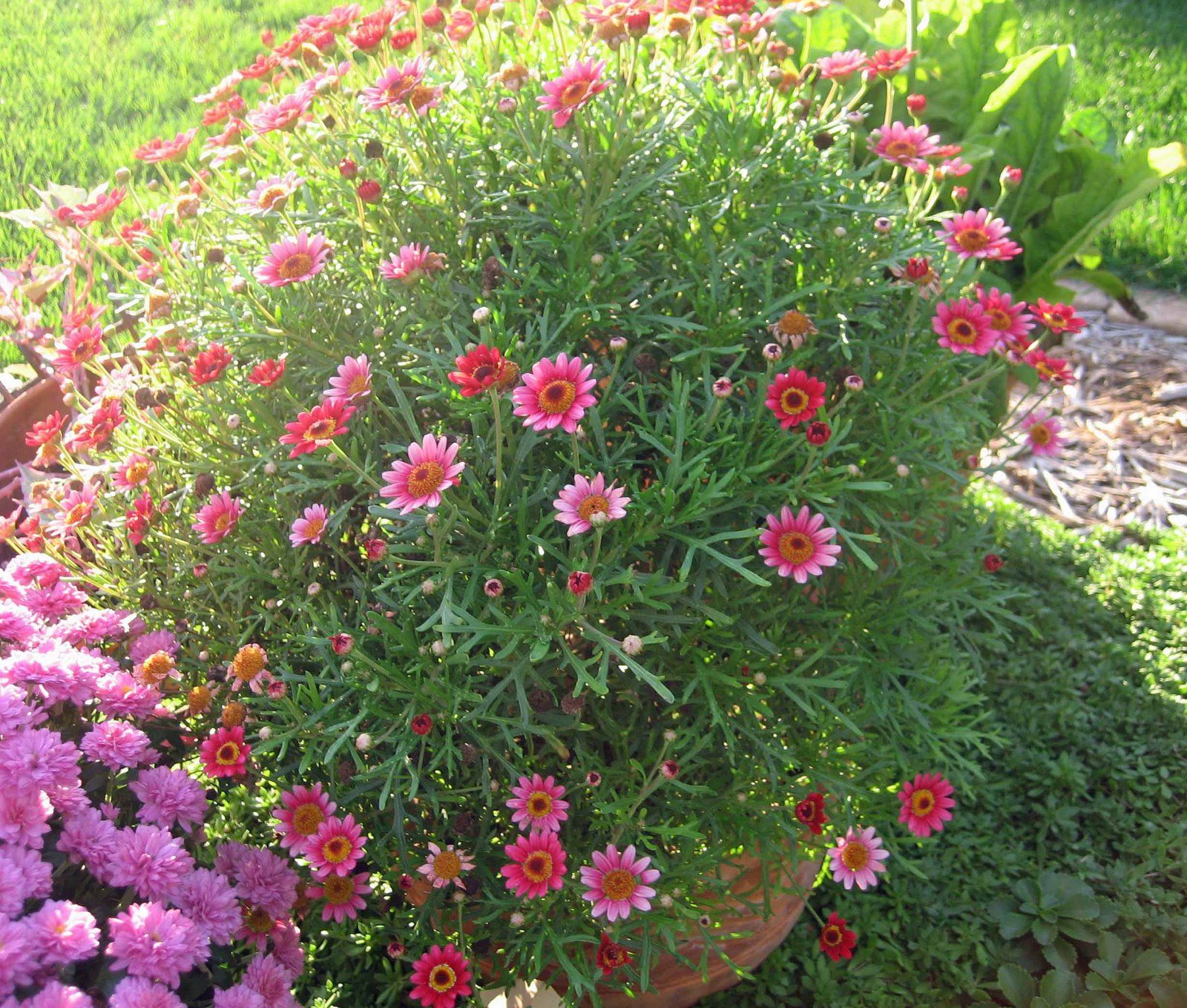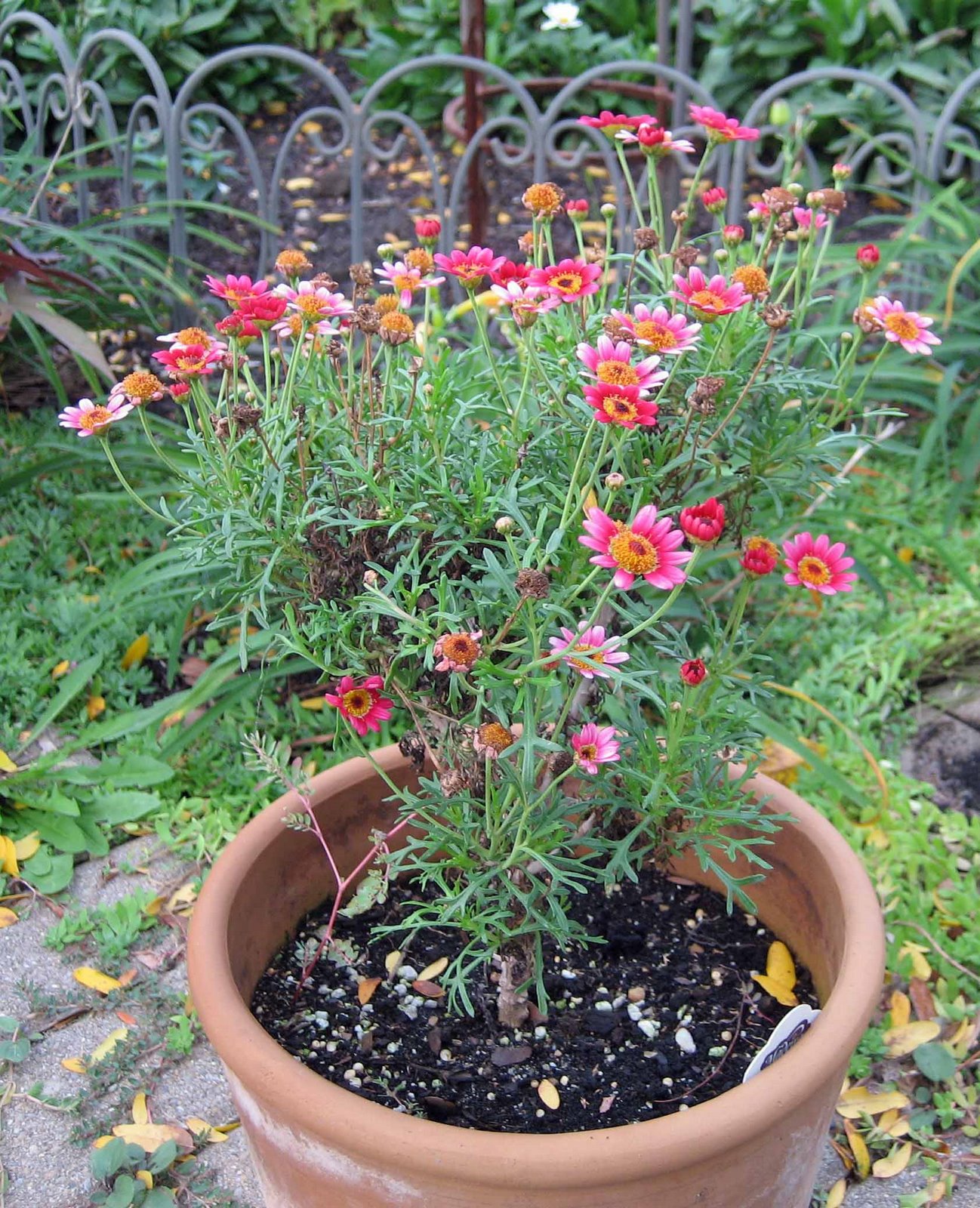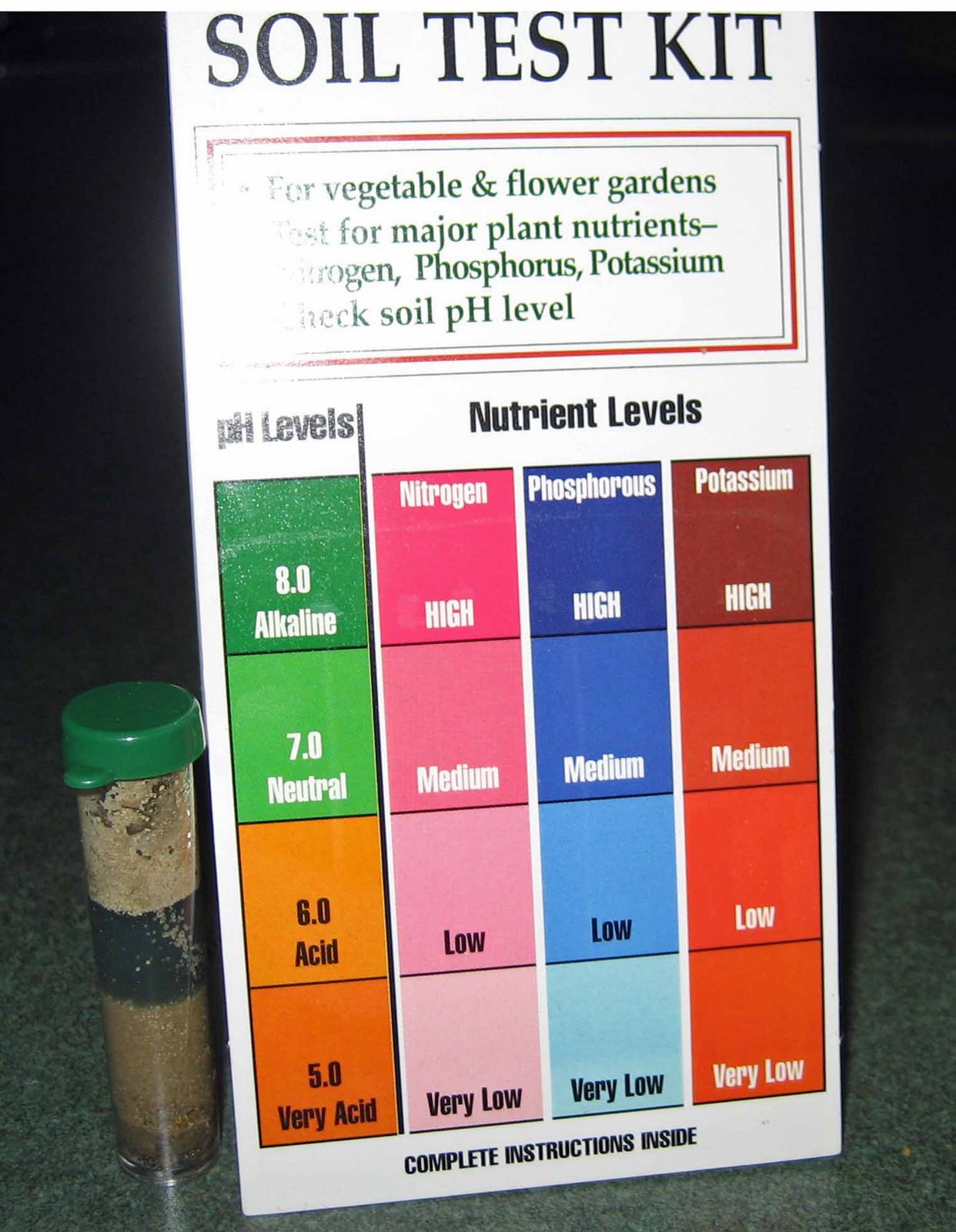 When plants in my garden don’t do as well as expected, I like to figure out why. This year, I planted two containers with Argyranthemum frutescens.
When plants in my garden don’t do as well as expected, I like to figure out why. This year, I planted two containers with Argyranthemum frutescens.
I bought the plants from the same garden center where they were probably growing side by side. I planted them with the same basic soil mix and though one was in the front garden and one was on the back patio, they were both out in the open so they got equal amounts of sun.
When I watered in the front, I watered in the back, so they got the same amount of water.
Yet, the one in the front clearly did much better than the one in the back.
 What could have caused this? The only difference I can find is the size of the containers. I used a smaller container for the one in the back but I have a hard time believing that the size of the container made that much difference. What else could it be?
What could have caused this? The only difference I can find is the size of the containers. I used a smaller container for the one in the back but I have a hard time believing that the size of the container made that much difference. What else could it be?
A few years ago I bought what I thought was a Red Oak (Quercus rubra) that never lived up to its potential. It always looked a bit sickly and showed signs of iron chlorosis, which is quite common in Pin Oaks (Quercus palustris) grown in alkaline soil. In fact, the whole reason I chose the Red Oak over the Pin Oak was because I figured my soil was probably alkaline. Most of the soil around here is.
After a few years of looking at the yellow leaves of that oak, I decided that once again I had purchased a mis-identified tree and this one was probably a Pin Oak.
In fact the more I looked at this tree, the more I was convinced that it was a Pin Oak. Why didn’t I realize that in the garden center? At one time in college, I was able to identify 10 or 12 different oaks commonly planted in the home landscape. But believe it or not, we were taught to identify them by their buds, and this one was all leafed out when I bought it. I was aware of the general leaf shape of Pin Oaks and Red Oaks, but they are somewhat similar. That’s my story, and I’m sticking to it. (And in case you are wondering, no, after all these years I could not identify a red oak from a pin oak by its buds. If you don’t use that kind of knowledge, believe me, you don’t remember it.)
Anyway, for a season or two, I tried to fix the soil for the Pin-Red Oak by adding sulphur to the soil around it but the results were mixed. I finally cut the tree down and put it out of its misery.
I’ve been thinking about that oak tree and wondered if the soil pH was really the problem or was it just a sickly tree?
I’ve never tested the soil in my garden, even though all the how-to gardening books seem to suggest that is the first step to a successful garden. I’ve always assumed my soil was alkaline and planted accordingly.
Soil pH, what does it matter?
It matters a lot to the plants.
So I found an old soil test kit I had bought years ago but never used, and tested my soil this evening. It’s a bit hard to tell from this picture, but guess what? Just as I suspected, and really knew all along, the soil pH around here is high.
It’s a bit hard to tell from this picture, but guess what? Just as I suspected, and really knew all along, the soil pH around here is high.
Will the confirmed knowledge that my soil is quite alkaline influence what plants I buy? Yes, it will and it already does. I would never have deliberately planted a Pin Oak, and I’ve avoided planting Rhododendrons and other shrubs that are known to prefer acidic soil, even though they are sold in the garden centers around here, where nearly all the soil is alkaline.
And it means that I’m going to give up on the idea of planting Halesia carolina, Carolina Silverbell. When I was doing my final checking to see if this was for sure the tree I wanted to get, I discovered the one thing I’d forgotten about it, it likes acidic soil.
Given my experience with the Pin-Red Oak, and the price of the tree, I don’t think it is a smart choice for my garden.
Instead I’ll go to the nursery as planned and just see what trees they have. But I’m taking one of my tree books with me, so I can do on the spot research before I buy a tree I’m not all that familiar with, even if that makes me look like a gardening geek.


I always thought we had a Pin Oak in the backyard, but one day I keyed it out and found that it’s a Scarlet Oak. So maybe your Pin-Red Oak was a Scarlet Oak? We have acid soil here, BTW, and the tree has been here a long time.
Good for you for thinking through your tree purchase. It would be so disappointing to plunk down a large sum of money just to sit back and watch your tree suffer.
I have tested my soil before. It is sandy with a high ph. I don’t bother with that any more. I work amendments into the soil and hope for the best. I try not to purchase something that needs acid. With a garden full of hydrangeas that sounds like a silly statement but I don’t mind shades of pink.
I’ve never tested my soil but after 27 years of gardening here I pretty much know if it likes alkaline soil it will be happy and if it likes acidic soil it will never do well. I do use organic fertilizer on the camellias for just that reason…at least they stay alive!
Take your book. You are not a geek. I love pin oaks and I sure hope the one in the front of our house is truly a Pin Oak! :o)
I like this post because testing my soil was something I was going to do next spring (in fact my next plant course I plan to take is about soil). I think I have alkaline soil but then I have 2 spruce trees and I hear that under them is always acidic soil. I can’t wait to find out so I can plant some azaleas.
i’m so impressed that you test your soil and isn’t it good that you now know about the tree you had your eye on!? no need to waste your money and energy.
No surprise that the soils in Indiana and Illinois are alkaline, Carol. If you want to grow anything in the acidic range you’ve got to really work on the soil. I have no problems growing Rhododendrons and Azaleas because I make sure they get the acid they need to thrive.
You are wise to do the soil test. Good luck with finding a good tree.
What a good idea to bring a garden reference to the garden center. I can’t tell you the number of times I’ve wished for one while shopping! Now I need to find a pocket-sized guide for impulse stops at favorite nurseries! Great idea! (But sorry about your tree). ~A 🙂
You? Look like a garden geek? Nawww. Well maybe if you wore your gardening belt with all the pockets for diggers and pruners. As usual, I’m impressed by your level-headed clear thinking about getting to the root of a problem. No pun intended. I’d probably just throw out the plant and cross it off my list of ones that do well in my garden! Good luck on your tree shopping.
I disagree with Carolyn Gail — If you want to grow anything in the acidic range you’ve got to really *decide whether it’s worth* work on the soil. If you plant something where the basics (climate or pH) aren’t appropriate, you condemn yourself to significant extra work for the life of the plant. It’s considerably less effort to look for a plant with the characteristics you want (white spring flowers?) that thrives in your climate and soil. Then you get to enjoy it instead of slaving over it. At least, that’s the choice I usually make!
I’ve never tested the soil here because there isn’t any. They scraped it ALL away when building the house. We were left with a hard crusted layer of packed clay and I don’t call that soil. I knew the soil here was alkaline, but usually I still plant the things I like without giving much thought to it.
Carol, I wish that more nurseries would include pH preference information on their plant labels. And while they’re at it, how about a humidity tolerance indicator? (anybody out there need a graduate thesis idea? Go to it!) Plant hardiness ratings just don’t tell the whole story!
I have to admit that my eyes start to glaze over when I read those soil analysis reports. But you give an excellent reminder here about the importance of understanding your soil. I think I’ve gotten along on luck and compost. Wonder what would happen if I actually did something with those reports?
–Robin (Bumblebee)
Entangled… I’m pretty sure it wasn’t a scarlet oak. My sister has a scarlet oak in her front yard, planted by my Dad 45 years ago, and it wasn’t the same as mine. But I’d take a scarlet oak any day!
Lisa at Greenbow… My hydrangeas are all pink, too. I don’t mind that either.
Leslie… This was the first soil test for me, and it confirmed what I already knew. I think gardeners get a good feel for their soil over time, and know what will do well and what won’t.
Mary… Thanks, I’ll at least have the book in my car!
Rosemarie… I’ve taken a couple of soil related courses, too. You’ll learn a lot.
Meems… Don’t be too impressed, this is my third garden and my first soil test.
Carolyn Gail… Thanks, and I’m still looking into your recommendation, a Katsura tree.
Angela… Thanks, but I don’t have time to go find a pocket-sized guide, I’ll just have to show up with my great big book.
LostRoses… Do you think it would be too much to wear my garden clogs, too? After all, we’ve had some rain so it might be kind of muddy at the nursery.
Chookie… I agree, it all depends on how much you want the plant. Carolyn Gail is from the south originally, so she has to have her azaleas, and it is clearly worth the extra effort to her. I think we’ve all got a few plants that we spend extra time and effort on that another gardener wouldn’t bother with.
Robin’s Nesting Place… Yeah, they don’t try to do too much to preserve the top soil in new neighborhoods, do they? It’s a shame!
Jocelyn… I’ll pass on the thesis idea, but really, don’t we want local nurseries to just sell what does well in the area? Around here, for example, rhododendrons do not do well. It’s like buying an annual shrub.
Robin(Bumblebee)… I’ve never had a full soil analysis done. I think for most gardens and gardeners, it isn’t that necessary to be successful. Better to just get out and garden and learn your own soil.
Thanks all for the comments and encouragement!
Carol at May Dreams Gardens
I don’t need to do a soil test because I found a detailed soil map at my library. I know the name of my soil type, what its composition is, how well draining it is (but I already knew that), and that it is slightly acidic (which is a surprise). If your soil retains moisture, you should be very happy with a Katsura. I wish I could grow 1, but my soil is too well-drained & it would not survive in a drought year. They are beautiful & have a nice, interesting scent to the fall foliage. It may not be as showy as Silverbell in Spring, but the rest of the year it is a more attractive tree. Good luck with it!
I’ve always been under the impression that our soils here are acidic, due to the acid rain, but what do I know? I’ve never had the soil tested.
I’ve got this silly azalea that I bought in Florida two years ago and last winter I left it in the ground and it actually lived! It didn’t bloom though and didn’t grow all that much this summer either.
There are a lot of oaks here, as well as evergreens and that’s another thing I thought – due to that, I assumed we had acidic soil.
But the hydrangeas do bloom pink . . .
I think I’ll have the extension office test our soil next spring.
Ah, the always challenging discussion about soil testing. Great responses and thoughtful post, as always.
Our soil is heavy clay, on the Annapolis Valley’s North Mountain; much of the soil in Atlantic Canada tends to be on the acidic side, except in areas where there is a lot of gypsum (and there are quite a few areas in my province). So I don’t bother with soil testing, because I also know that soil can vary in its acidity or alkalinity around a property almost as much as the microzones can vary. Mostly I just amend with compost and manure, and avoid things that tend to prefer alkaline conditions, because otherwise we’d be doing soil testing all summer around our 7 acre spread!